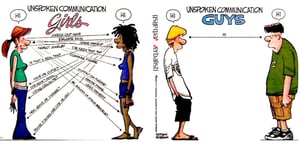Demographic Segmentation is often used in all forms of direct marketing when the marketer has the statistical information about the audience she’s aiming at. Typically it’s things like gender, average age and level of income that make a difference. On the web its no different especially when publishers have the information about their customers and can tie that into anonymous web analytics data. There are various ways to attach CRM data anonymously to your web analytics data and then trigger different actions, but this lens isn’t going to focus on the technical aspect. We’ll focus instead on the differences between men versus women.
Men versus Women
What men and women do on the web is often different. These differences can make a difference to your bottom line if you’re selling something online which lets face it most of you are.
Advertising Demographic Segmentation.
In some client websites we’ve looked at we’ve seen that women tend to be more receptive toward paid advertising. For instance paid search traffic we’ve noticed across different clients and types of industry that women tend to click the paid search links more than the men do. This isn’t a statistically valid study we’ve done it’s just a trend we’ve noticed and therefore worth A/B testing against. If you’re in the publishing industry for instance and you know which of your audience is female that could be very valuable information for your advertisers. Could you test pushing more ads to the ladies, catering more for their tastes when you know they are ladies?
Purchasing Demographic Segmentation.
We also noticed on some of our sites that women tend to buy more items with a lower order value than men. We can’t tell you if that means anything it’s again just a trend we’ve noticed but its something that if you can A/B Test you should. For instance if you found that was the case on your website, could you present the least expensive items first for the ladies and the most popular (regardless of price) for the men? We notice as well that a greater proportion of women tend to purchase tickets or make bookings for trips. I have no idea why this is the case, but its worth testing campaigns that focus on the lady if you’re in the travel industry to see if you get an uplift.
Search Demographic Segmentation.
You have tracked your internal search engine right? (if not do it!). But the differences between what a man might search for and what a women searches for on the same site are often staggeringly different. 30-60% of the top searches women made on sites we looked at weren’t in the top searches the men made. So that is a simple A/B test you can do. If you find out that one gender is looking for different things than the other and you can somehow identify they are male or female its worth testing if pushing a different landing page to the men and women works. Personalising home pages or top landing pages based on gender searches could make your user experience so much easier for your customers.
Action Points
- Enrich your web analytics data with demographic data.
- Set-up analytics segments that show the behavioural differences between men and women on your website.
- Define some tests you could do.
- If the tests work, make the changes permanent, if they fail, go back to action point 3.
- Repeat action points 3 and 4.


